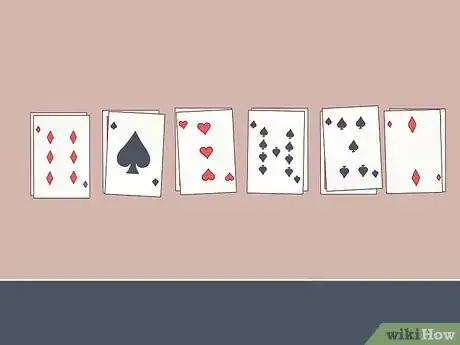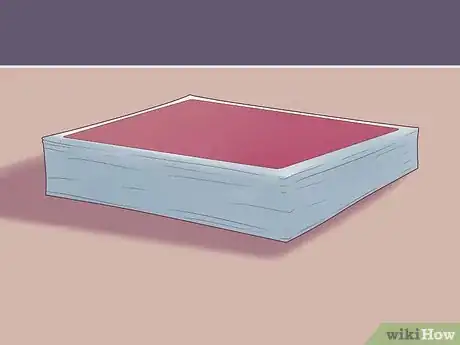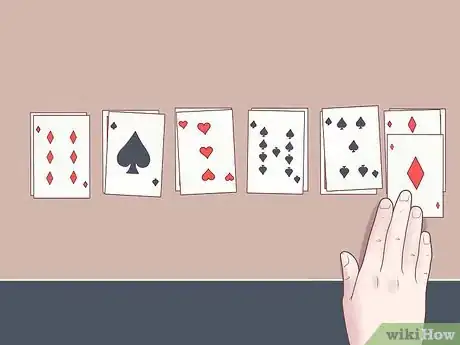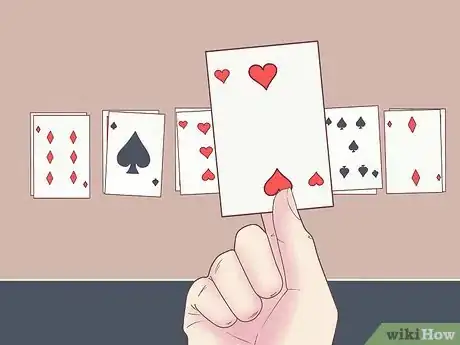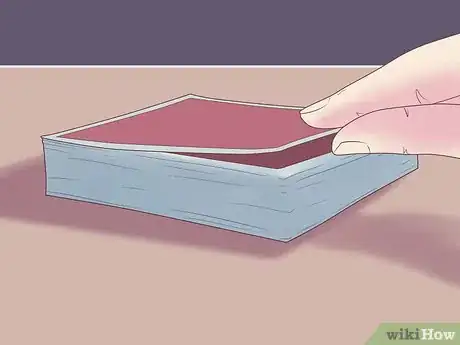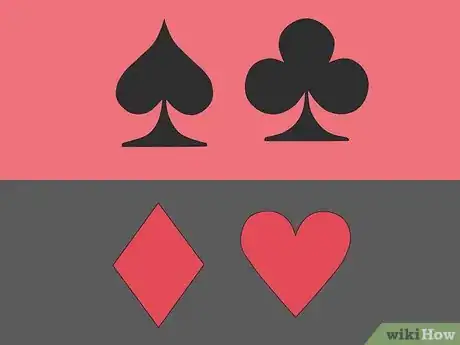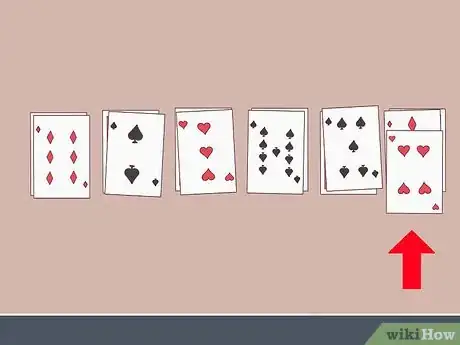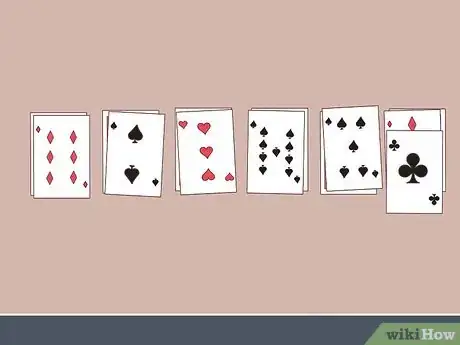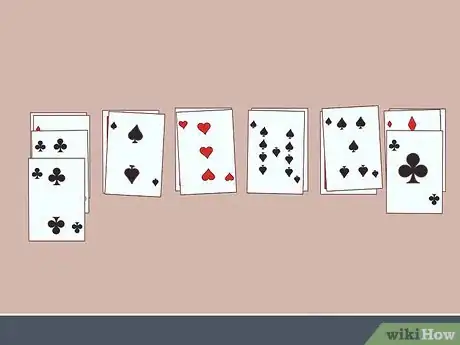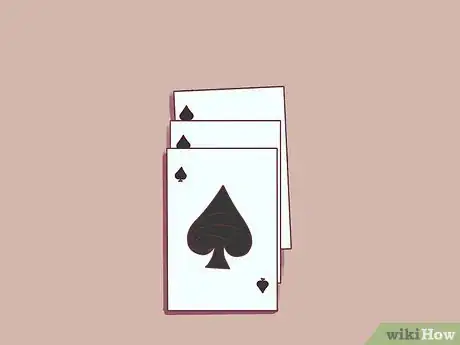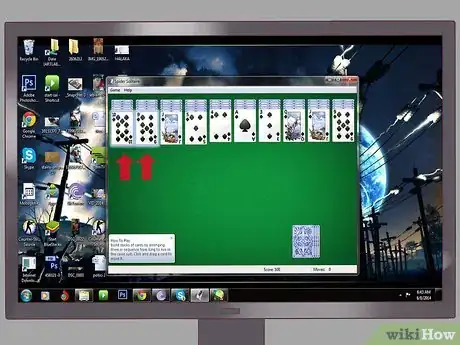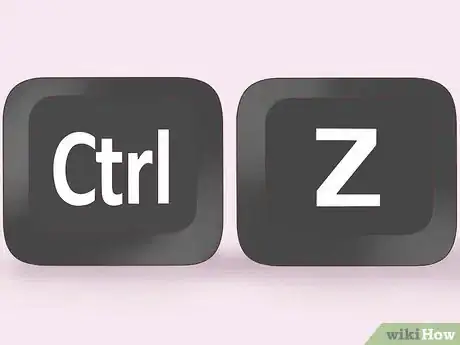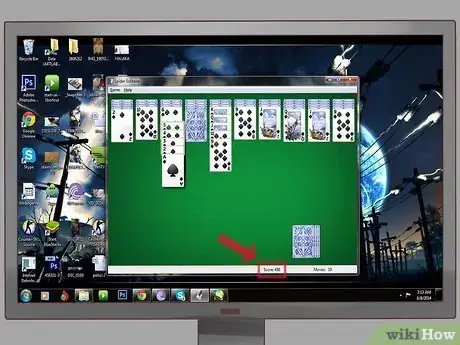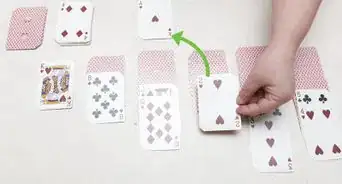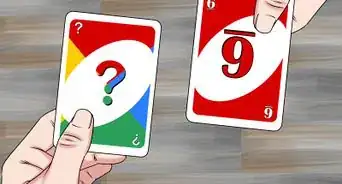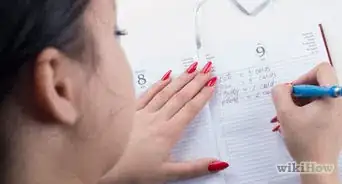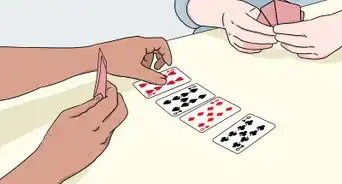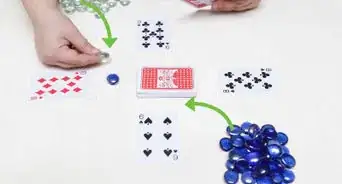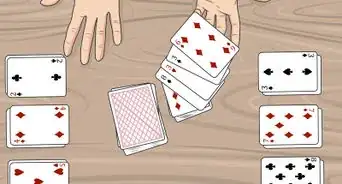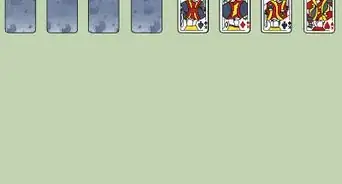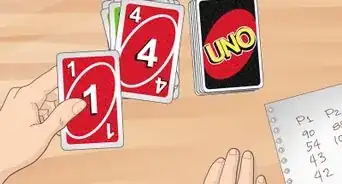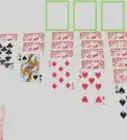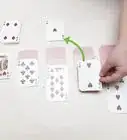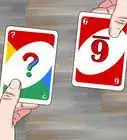wikiHow is a “wiki,” similar to Wikipedia, which means that many of our articles are co-written by multiple authors. To create this article, 18 people, some anonymous, worked to edit and improve it over time.
This article has been viewed 215,782 times.
Learn more...
Spider solitaire is a single-player card game usually played with 2 decks of cards, although numerous variations exist. Some common spider solitaire variations include using 1, 3 or 4 decks, or using only 1, 2 or 3 suits from each deck of cards. However, the same basic rules apply, no matter which variation you play.
Steps
Playing One Suit Spider Solitaire
-
1Shuffle 2 decks of playing cards together. For this, don't take any cards out (apart from the jokers) -- just look past the suits and pretend they're all the same. Otherwise you'd need way more decks!
-
2Deal 10 piles of cards out in a horizontal line. Each card should be face down and vertically oriented. Each of the first 4 piles should contain 5 cards, and the last 6 piles should each contain 4 cards.Advertisement
-
3Deal another card, face up, on each of the 10 piles. The first 4 piles should now contain a total of 6 cards (with the uppermost card face up) and the last 6 piles should now contain a total of 5 cards (uppermost card face up).
-
4Set the rest of the combined decks aside, face down. This pile is known as the "stock." You'll be drawing from it when you run out of moves on your tableau.
-
5Build sequences of cards in descending order by doing the following:
- Move any face-up card onto a card with the next-highest value in the deck, regardless of suit. For example, a Queen of any suit can go on top of a King of any suit; a 7 of any suit can go on top of an 8 of any suit.
- Place each new card slightly lower than the card you're playing it on, so you can still see the value and suit of each previously played card.
- You can move the card closest to you in each face up stack to another stack at your convenience. You can only move several face-up cards together if they're all in descending order. For example, the K-Q-J-10-9 or 5-4-3 (of any suit) can be moved together as a single unit.
-
6Turn face-down cards face-up as they become uncovered. You cannot leave any piles unturned (why would you want to?). Once you deplete all the cards from a particular pile, you can fill the empty space with any face-up card or descending sequence of suited cards.
- You cannot use the stockpile if you have any empty columns to fill. Simply take a card (or a bunch) from a stack and place it in the empty column.
-
7Use the stock when you run out of moves. If you're looking at your tableau and you don't see anything you can possibly do, turn to your stock. Deal one card face-up from the stock onto each of the 10 card stacks, then continue play.
- When you run out of stock cards to add and can't do anything, wah wah. Game over. Playing with one suit is fairly doable, but when you hit two and four it becomes rather difficult.
-
8Remove King-through-Ace sequences from play as you succeed in creating them. Set them aside face-up. When you have 8, you're finished!
- Take care to keep the completed sequences separate from the stockpile you set aside after the initial deal.
- Play ends when you've succeeded in creating all 8 "builds," or suited King-through-Ace sequences, or when no more moves are possible.
Playing Two-Suit Spider Solitaire
-
1Deal out your cards in the same fashion as you would with the one-suit version. You're using the same amount of cards in the same format. That's piles of 5 on the right and piles of 6 on the left (turned-up card included). The stock is the same, too.
- If you're unsure as to what that fashion is, read up on the one-suit version. It's much easier and every new player should start with it.
-
2Think in reds and blacks. Instead of completely ignoring the suits, this time you're just going to lump them by color. That is, hearts and diamonds are "one suit" and clubs and spades are another.
-
3Move clusters of the same color. For the one suit version, you just needed to make numerical sequences (7-8-9, for example). Now you can still make those sequences, but you can only move them in chunks if they're the same color. That is, you can put a 7 of hearts on an 8 of spades, but you can't move them together.
- You could, however, move a 7 of hearts and an 8 of hearts (or diamonds). This adds a considerable level of difficulty to the game.
-
4Know that the rest of the rules apply. The rest of the game is the same, regardless of whether you're playing one suit, two suit, or the four suit version. You still use the stock when you have no moves to make, you still have to turn over face down cards when they're open, and you still have to have cards in every pile before you can use the stock.
- And the format is the same, too. Same amount of cards, same amount of piles. If you skipped method one, you may wish to refer to it. What's more, if you're new to Spider Solitaire, definitely start with one suit -- it's much, much easier!
- Again, the only difference is how you move the clusters, not how you make them. So be very careful when you move that red card onto that black card -- you may not be able to get to that black card for a while!
Playing Four-Suit Spider Solitaire
-
1Deal out the cards in the same manner. Four Suit Spider Solitaire is intense, but it's the exact same in format and play. Use the same amount of cards, use the same set-up, and use the same basic rules for winning.
-
2Recognize all the suits. This time, you're seeing the suits for what they are. Diamonds are diamonds, spades are spades, etc. Just like in the two-suit version, they must be played together. In order to get King-to-Ace sequences cleared off the table, they must all be of the same suit.
-
3Move them in uniform clusters. You can make any numerical sequences you'd like (6-7-8-9, etc.), but they can only be moved within their suit. A six of hearts on a 7 of spades on an 8 of diamonds is going nowhere. However, a six of hearts on a 7 of hearts on an 8 of diamonds? The 6 and 7 can be moved.
- See how this gets virtually impossible? When you're moving the cards around, you're going to have to know which allowances to make and which moves to avoid. In general, you want to open piles and rows -- if the move doesn't do that, you may be best off skipping it.
-
4Utilize strategy. The four-suit version is really the only version where it's strategy over all (not ignoring luck). To make your sequences and clear them off the board (which is how you win the game), you gotta be very careful.
- Go for higher ranked cards first. In other words, move the Jack onto the Queen before you move the 10 onto the Jack. If you move a 10 onto a Jack that's a different suit, you're virtually killing it.
- Move Kings to open columns as soon as you can.
- Get cards off of columns that are almost empty. The sooner you get empty columns, the sooner you can get your Kings off the column and off the table.
- Though it should go without saying, try your best to keep sequences within a suit. As the game progresses, you'll be glad you did.
Playing Spider Solitaire on Windows
-
1Choose your level of difficulty. If you're a newbie to the Spider Solitaire scene, you'll want to start off with one suit. It's not shameful -- two-suit and four-suit are hard. Once you get accustomed to one-suit, you can move onto the harder versions.
- A large part of this game is luck. If you get thrown bad sequences from the stock, you could be outta luck. Play a handful of games before you write off your skill.
-
2Take advantage of the "Hint" feature. Pressing "H" tells Windows you could go for a little assistance. It'll then light up the next card you should move. Don't hit it freely though -- try to take a look as to why that was the best next move.
- Try to limit yourself to a few hints each game. Relying on it too much prevents you from having to figure out patterns and strategy.
-
3Don't be afraid of the "Undo" button. Especially if you're doing four-suit solitaire, the undo button will be your best friend. Consider it "peeking." If you're not sure whether you should move a card or not, move it, see what's under it, and if it's not worth it, put it back!
- Same goes for this button as the hint button. You don't want to depend on it, but it's good to have if you really, really need it!
-
4Know the scoring. In the Windows version, you start out with 500 points. With every move you make, it subtracts a point. Then, if you win, it multiplies that score by 100. See if you can beat your own personal record next time!
Community Q&A
-
QuestionCan you help me find a version of Spider Solitaire that uses four separate decks of cards?
 ChristopherTop AnswererWindows Spider Solitaire has the advanced version, where it uses four decks (four different types) of cards. You may need to look online if you don't have a Windows PC, but finding one should be rather easy.
ChristopherTop AnswererWindows Spider Solitaire has the advanced version, where it uses four decks (four different types) of cards. You may need to look online if you don't have a Windows PC, but finding one should be rather easy. -
QuestionCan I play spider solitaire with one deck of cards?
 Community AnswerYes, you can change it to six stacks of cards, two stacks of six cards and four stacks of five cards.
Community AnswerYes, you can change it to six stacks of cards, two stacks of six cards and four stacks of five cards. -
QuestionHow do I score points in the game?
 Thomas EllsworthCommunity AnswerYou score points in the game by building King-through-Ace sequences (remember that the sequence needs to be in the same suit).
Thomas EllsworthCommunity AnswerYou score points in the game by building King-through-Ace sequences (remember that the sequence needs to be in the same suit).
wikiHow Video: How to Play Spider Solitaire
Things You'll Need
For Hand-Held Methods (1-3)
- 2 decks of playing cards, Jokers removed
References
About This Article
To play Spider Solitaire, first you’ll need to shuffle together 2 standard decks of playing cards. Deal 10 columns of cards face down in front of you. There should be 6 cards in each of the first 4 columns on the left, and 5 cards in each of the other 6 columns to the right. Flip the top exposed card on each column face up. The goal of the game is to organize all of the cards in sequences ascending from aces to kings. Face up cards can be moved onto other face up cards in a different column as long as the card being moved is one rank lower than the card it’s been played on. If moving a face up card exposes a face down card, the face down card can be flipped face up. You can move multiple face up cards within the same column as a stack. Once you’ve created a sequence of face up ace through king cards, move the sequence to its own pile above the columns. Whenever you get to the point where you’re unable to make any more moves, take the leftover deck of cards and deal 1 card face up on each column. Then, continue the game. Play continues until you’re able to organize all of the cards into sequence piles, at which point you win. There should be 8 sequences in total. If you’re unable to make any more moves and you run out of extra cards in the deck, the game is over. For tips on how to win spider solitaire and play 2-suit and 4-suit versions, read on!


